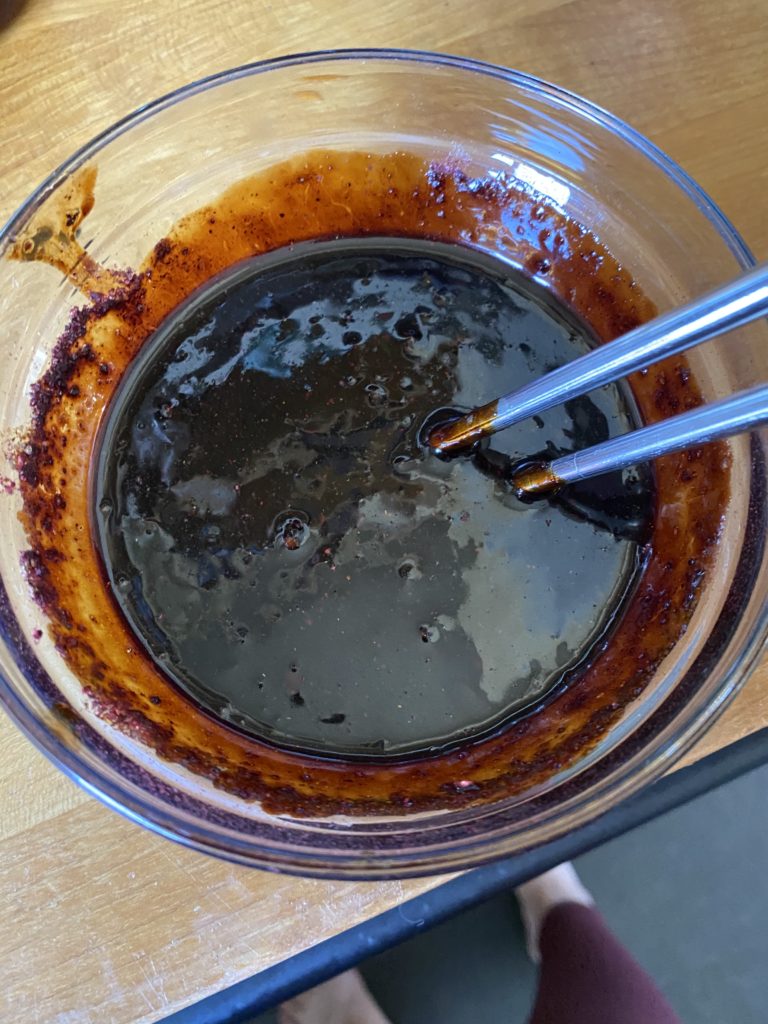Wedgeford Brown

Wedgeford Brown is a sauce made with fermented broad beans, vinegar, and a handful of other things. Not everyone has the time and/or inclination and/or ability to ferment their own broad beans and to make their own vinegar, so this is a description of how to make this out of materials that are almost all regularly available in an Asian grocery store (or on Amazon).
Note: I’m giving a ton of potential substitutions, because look, if I’m not fermenting my own broad beans, it’s all a janky substitute anyway, so take this as a general guide, not an absolute. This describes how I made the sauce that I will call “Wedgeford Brown” in all further recipes.

1. In a small-ish glass bowl, start with 2 Tbsp of dark soy sauce. You may be wondering: is dark soy sauce any different than the regular soy sauce you get in little packets when you order Chinese food, or that you buy in non-Asian grocery stores? The answer is...yes. You might wonder why one is called “dark” soy sauce and the other is called “light” when they look to be exactly the same color. You will see the difference if you pour them and compare them. Dark soy sauce is thicker and has a stronger flavor. Aesthetically, light soy sauce (in most small quantities) will effectively disappear in sauces and stir fries, leaving the colors basically unchanged. Dark soy sauce will color everything.
(If you can’t get dark soy sauce, or if you have gluten intolerances, it’s not the end of the world. My personal substitution would be to use 3 Tbsp tamari/light soy sauce and thicken it slightly with corn starch or potato starch, which will require cooking.)
 2. Add 1/2 tsp black vinegar. I personally love the taste of black vinegar, but you’re mostly adding this for a hint of acid. If you don’t regularly use black vinegar in your cooking, I do not advise getting it for the sake of using 0.5 teaspoons in this recipe. Literally anything sour will do—apple cider vinegar, white vinegar, lemon juice. Even something like pickle juice will probably work.
2. Add 1/2 tsp black vinegar. I personally love the taste of black vinegar, but you’re mostly adding this for a hint of acid. If you don’t regularly use black vinegar in your cooking, I do not advise getting it for the sake of using 0.5 teaspoons in this recipe. Literally anything sour will do—apple cider vinegar, white vinegar, lemon juice. Even something like pickle juice will probably work.
 3. 1 tsp Chinese five spice powder. For all the other things here, I’m pretty carefree about substitutes. There really is no substitute for five-spice powder (except making your own). If you’re not used to this, the idea of adding cinnamon and anise and cloves to a savory sauce that is used on meats might take you by surprise, but it’s really, really good and you shouldn’t worry too much about it.
3. 1 tsp Chinese five spice powder. For all the other things here, I’m pretty carefree about substitutes. There really is no substitute for five-spice powder (except making your own). If you’re not used to this, the idea of adding cinnamon and anise and cloves to a savory sauce that is used on meats might take you by surprise, but it’s really, really good and you shouldn’t worry too much about it.
4. This is the part where you’ll have to use a little knowledge of your personal tastes. You’re going to add fermented broad bean sauce. Toban Djan (pictured) is what I used, but this has chili in it. It is not mild. If you’re heat-sensitive, you don’t want this. But the non-hot version of just fermented broad bean paste (doubanjiang, NOT la doubanjiang) is actually not super-easy to find. I’m just going to go ahead and say that if you don’t want spicy, get a nice not-spicy fermented black bean sauce (like this one) instead.
I used 2 Tbsp of the hot version because I love heat, but my husband can only handle mild versions. If you want it hotter, 4 Tbsp. If you want it not hot at all, 2 Tbsp doubanjiang or black bean sauce.
5. Sweetener. This is entirely up to you. I used 4 Tbsp of rice syrup. You can use honey, regular sugar, sugar substitutes (although be aware that many sugar substitutes will require you to heat them up to mix thoroughly... they don’t dissolve at room temperature)... Pretty much anything. Because I’m suggesting a wide range of ingredients above, I suggest adding this a teaspoon at a time, tasting as you do. Add sweetener until you can taste it, then add one more tablespoon. You’ll need a lot.
6. This is the one that’s hardest to get: 1 Tbsp of red yeast rice, ground. Most of the places that sell it do so as an herbal supplement, and I just don’t really advise getting the herbal supplement and then opening up pills for this.
Want a whole bunch of red yeast rice as a flavoring agent? Here is the place I found to buy it.
Please be aware that red yeast rice is a component in Traditional Chinese Medicine used to lower cholesterol, and there are a bunch of potential drug interactions, particularly with statins, so... be safe.
In all honesty, having tried this both with and without the red yeast rice, please just skip this unless you are really determined to get the full experience.
6. Mix all these things together with whatever implement you choose.
Ta da! Here is your Wedgeford Brown.


P.S. I hope you all got hungry reading this book, because if you’re wondering why I’m making this massive food glossary with lengthy descriptions of substitutions, it’s because I was hungry the entire time I was writing this book.
